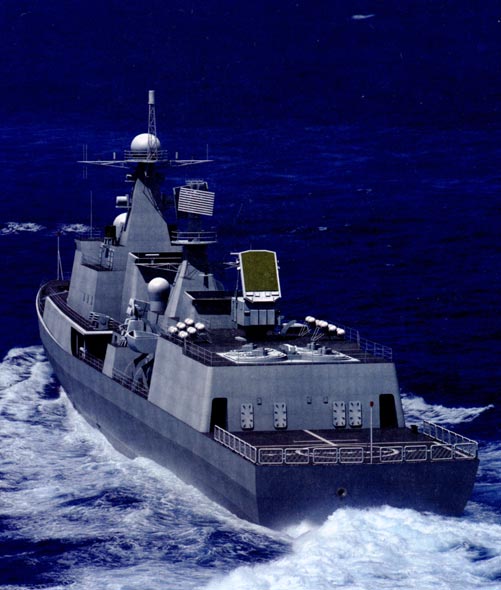In this post we'll explore ROCN's domestic warship & aircraft building possibilities.
Under current political realities, it's very unlikely that the ROCN can import warships and naval weapons from foreign suppliers other than the US. European suppliers are willing to provide certain components, such as engines, electronics, sensors, etc., but items like Aster SAM, and even RIM-116 (US-German product) are out of reach. The US, being cautious about maintaining the status quo, will only provide limited defensive armaments and munitions to ROC.
Taiwan CSBC Corp had license built 8 OH Perry class FFG's in 1990's, the last one completed in 2002. Both Australia and Turkey have developed upgrade programs for their OH Perry class ships. The upgrade adds an 8-cel Mk.41 VLS (for quad-packed ESSM) in front of Mk.13 launcher, and the Mk.13 launcher itself to handle SM-2MR and Harpoon SSM's. Here's a pic of Mk.41 VLS on HMAS Sydney:
The Australian upgrade ran into various technical problems, but they're spending the time and effort to fix it. If ROCN opt to follow this example, they'd benefit from Australian and Turkish experience and
not reinvent the wheel. The ROCN OH Perry ships are fairly new, unlike the Knox (40 years old) and Kidd (30 years old). Plus they were built with longer hulls, so hull-extensions aren't necessary.
Should the US agree to export the upgrade components, ROCN OH Perry class FFG's could carry up to 40 x SM-2 rounds (or other missiles) in the Mk.13 launcher, plus 8 x 4 = 32 ESSM in the 8-cel VLS. Combined with upgraded sensors, it'd improve ROCN AAW capability with existing fleet.
If the upgrade is too expensive, if the US is unwilling to export ESSM, the 8-cel VLS can still be installed and loaded with SM-2MR SAM (or other munitions, such as VL-ASROC) as an incremental upgrade.
================
In early 1990's, the ROCN had considered building its own Aegis warship under the Tien Dan program. The original plan was to install AN/SPY-1F on 4 enlarged OH Perry hull, built by CSBC. The plan was later abandoned due to technical uncertainties.
Moving forward, European navies have successfully integrated the Aegis system on platforms such as the Fridtjof Nasen class FFG (5,290 tons loaded), and the Alvaro de Bazan class FFG (6,250 tons loaded).
I'd like to see this plan revived, for construction of 4 x 5,000 - 6,000 ton displacement AAW FFG's, at the cost of no more than $4 to $5 billion USD. The Europeans already did their work on figuring out how to integrate the various systems with US input, so again, it's not reinventing the wheel.
The basic parameters of the ship is AN/SPY-1D or 1F sensors, "export" grade Aegis combat management system from US, 4 x 8 to 6 x 8 Mk.41 VLS cels, main gun, CIWS gun, torpedoes, 8 x SSM, ASW helicopter, sonar/decoy, etc.
==================================
In the event that the US refuse to export advanced ship technology and Aegis sensors/systems, the ROCN might want to consider "plan B" with its own AAW ship. Some of you will think I'm completely nuts here, basically I'm suggesting a ROCN version of the PLAN 051C. Instead of S-300/SA-N-6, ROCN will use naval version of TK-2/3 SAM, TC-2 SAM, and HF-2/3 SSM, along with licensed copies of phased-array radar system from Lockheed Martian (currently used for TK systems).
The ship's displacement will be 5,000 to 6,000 tons, with 4x8 or 6x8 square-lid type VLS for TK-2/3 naval VL-SAM in front, 2 x 8 cel naval TC-2 VL-SAM along the smoke stack, and 2 x 4 ce HF-2/3 SSM in center. There would be sufficient space in the aft deck for helicopter/UAV hanger, unlike 051C. The ship's primary role will be AAW but still carry decent ASW systems. It'd also have the usual main gun, CIWS, torpedoes, helicopter, etc.
Afterwards I'd suggest licensing Patriot PAC3 technology for newer & smaller TK-X SAM that could be quad-packed like existing PAC3 systems. This way the limited number of VL cels on the ship can allocate some for quad-packed TK-X like ESSM. if you license the technology for local manufacture, you gain some reference-engineering capability in case of arms embargo.
===============
A bigger FAC/Missile Boat
The Kuang Hua VI class FAC is small (180 tons) and lightly armed. OK for hit and run, but not much use beyond that. I'd like to see a larger FAC with 400-500 ton displacement, armed with Oto 76mm or Bofors 57mm Mk3 gun in front, 4 x SSM, and a medium RCWS in the back that could be used for 20mm-40mm AC or AC + missile mount.
===============
ROCAF
The F-5 E/F are facing retirement, and F-16 C/D purchase is delayed. I'd suggest upgrading existing fleet of IDF to C/D standard as an interim solution.
AIDC had offered to manufacture IDF LIFT variants for $16 million each. Cheap, but this is really not where they should be heading. They should revive the older upgrade projects, such as the more powerful TFE-1042-70A or GE J101/SF engines (or better), increased fuel (CFTs?) & payload capacity, and build ~120 new fighter aircraft (IDF-E/F? IDF-XL?). After the new aircraft enters service, the older A/B and C/D variants can be delegated to combat trainer duty.
Recently, I read an article about Korea's KF-X program (120 aircraft) estimates being placed at $10 billion:
This is quite a number and would probably give Taiwan's ADF program pause. I think the ROC should allocate funds to ADF R&D and feasibility study. If the US won't supply advanced combat jets in the future, then ROC has no choice but the do it the "IDF" way. Assuming cost is similar to Korean estimates, 120 jets at $10 billion comes out to $83.3 million each.






